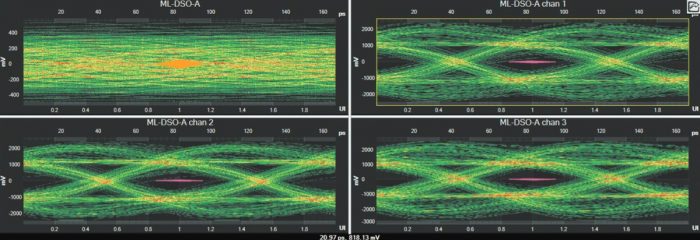Integrators would be wise to question how HDMI Rev. 2.1 will affect their businesses, especially with preliminary tests showing inconsistencies between manufacturers.
HDMI Rev 2.0 Cables Are Unlikely to Pass Rev 2.1 Tests

Figure 1: This failed sample cable would have worked under Rev 2.0 when only three video lanes were used along with a clock sync lane.
Way back, more than three years ago now, when the announcement of Rev 2.1 hit the streets, every integrator wanted to know how this new HDMI revision was going to change what they sell and install compared to the 2.0 video transmission. After all, it affects them in the field and in the bank.
Well, we’re getting more and more products sent in for preliminary testing with 2.1 these days, and integrators should still be questioning how it will affect them. That’s because the results can be a little scary.
Let’s just focus on one set of eye patterns (Fig. 1, above) this month. Have you figured out what is going on here? Obviously, we have one of the four video channels not doing very well and, in this case, it is the 0 channel — which is the older Rev 2.0 clock channel. To remind you, every time a product is sent into DPL Labs, we request five samples to test if the consistency of the product line is good. In this case they were consistent all right — they all failed!
First Contact with 48G Already Unearthing Anomalies

Now, this cable would have been perfect for the older Rev 2.0 18Gbps time frame because with that system only three video lanes were used, and the 0 channel was for clock sync of 150MHz compared to the video at 6Gbps data rate. Why have a 6Gbps video grade channel for the clock when you can get by engineering a far less expensive cable product by using inexpensive material and reduced gauges for a clock channel?
With the old interface design, the HDMI cable channels included three video lanes and one clock lane. But under Rev 2.1, if you recall, the clock channel is now being used as a fourth video lane requiring 12Gbps.
It makes one wonder why the manufacturer bothered to send the product in for testing.
Did the company:
- Just send the wrong samples (doubtful)
- Produce the entire spool poorly and nobody checked (possibly)
- Think it could sneak by testing (unlikely)
- Send older 2.0 cables to see if they can pass the DPL 48G
- Reference Standard without any new design (my guess)
Either way, clearly some manufacturers are not totally prepared for this level of transmission, despite having three years to work on it. We could cut them some slack, since perhaps they were just waiting on the cable Compliance Test Spec. That would still be somewhat troubling and irresponsible, however. Without every manufacturer on board with Rev 2.1 needs, we’ll still see issues in the future.
DPL provides an extra preliminary service for members so they can see if their new designs will in fact pass the new 48G numbers. Although it can get a bit overwhelming with all these samples, it provides a mechanism to get working products in the field.
Remember, the typical passive device you will see is only about 3 to 5 meters. But just imagine loading up your truck with these cables, keeping in mind past interoperability experiences, and you can get very antsy installing even short lengths that should be a no-brainer for functionality. Do your due diligence and research what you use — it will save you time and money.

Recent Comments